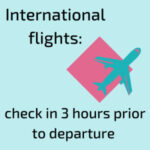Air travel during pregnancy raises many questions for expectant mothers. While generally considered safe, understanding when to limit or avoid flying is crucial for a healthy pregnancy and safe travels. This guide provides a comprehensive overview of recommendations and precautions for pregnant women considering air travel.
Is it Generally Safe to Fly During Pregnancy?
For most pregnant women, air travel is perfectly safe, particularly up to the 36th week of gestation. If you are experiencing a healthy, uncomplicated pregnancy, flying is usually not restricted. However, it’s always wise to consult with your healthcare provider before making flight arrangements. They can offer personalized advice based on your specific health status and pregnancy progress.
Your healthcare provider might advise against flying if you have certain pre-existing conditions or pregnancy complications that could be exacerbated by air travel. These conditions might include a history of miscarriage or unexplained vaginal bleeding, severe anemia, or poorly controlled high blood pressure or diabetes. Furthermore, if you have a history of preeclampsia from a previous pregnancy, or if you are expecting twins or multiples, flying may not be recommended. These conditions increase the risk of complications that could be challenging to manage mid-flight or in a foreign location.
It’s also important to consider the duration of your flight. Longer flights inherently carry slightly increased risks due to prolonged immobility and potential dehydration. Discuss the specifics of your travel plans, including flight duration and destination, with your healthcare provider to get tailored advice. Additionally, be aware that some airlines impose their own restrictions on pregnant travelers, particularly on international routes. Always check with your airline regarding their specific policies for pregnant passengers before booking your tickets. Many airlines restrict travel after 36 weeks for domestic flights and even earlier for international flights.
Navigating the Trimesters: When is the Best Time to Fly?
While flying might be permitted for much of your pregnancy, the optimal time for air travel is often considered to be the second trimester. This period, generally from week 14 to week 27, is often associated with fewer common pregnancy discomforts like morning sickness and fatigue. Moreover, the risks of spontaneous miscarriage or premature labor are statistically lower during the second trimester compared to the first and third trimesters.
After the 36th week of pregnancy, most healthcare providers will advise against air travel due to the increased risk of going into labor. Airlines also frequently enforce restrictions beyond this point. Even before 36 weeks, if you are nearing your due date, it’s prudent to consider the potential risks and benefits carefully. If travel is essential in the late stages of pregnancy, ensure you have a detailed discussion with your healthcare provider, and understand the airline’s policies thoroughly. You might be required to provide a letter from your doctor confirming your due date and stating that you are fit to fly.
Essential Tips for Safe and Comfortable Air Travel During Pregnancy
If your healthcare provider gives you the green light to fly, there are several measures you can take to ensure a safer and more comfortable journey:
-
Seatbelt Safety: Always keep your seatbelt securely fastened whenever you are seated. Position the lap belt below your belly and across your hips for maximum safety and comfort.
-
Stay Hydrated: Airplane cabins have low humidity levels, which can lead to dehydration. Drink plenty of water throughout your flight to stay well-hydrated. Avoid excessive caffeine and sugary drinks.
-
Dietary Considerations: Steer clear of gas-producing foods and carbonated beverages before and during your flight. Gas expands at higher altitudes, which can cause bloating and discomfort. Foods like broccoli, beans, and carbonated sodas are best avoided.
-
Medical Preparedness: Plan ahead for potential medical needs during your trip. Research healthcare facilities at your destination and carry copies of your prenatal medical records. Knowing where to seek obstetric care if needed provides peace of mind.
Alt text: A pregnant woman carefully fastens her seatbelt low across her hips while seated on an airplane, emphasizing safety during travel.
Minimizing Risks: Blood Clots and Radiation
Prolonged air travel can slightly increase the risk of developing blood clots, known as venous thrombosis, particularly in the legs. Pregnancy itself is already a state that elevates this risk. To mitigate this:
-
Regular Movement: Make it a point to walk up and down the aisle every hour or so. If you are restricted to your seat, perform ankle circles and foot flexes frequently to promote blood circulation.
-
Appropriate Clothing: Avoid wearing tight-fitting clothes that can restrict blood flow. Opt for loose, comfortable attire.
-
Compression Stockings: Consider wearing compression stockings, especially for longer flights, to aid blood circulation in your legs.
Regarding radiation exposure during air travel, the levels encountered during typical flights are not considered harmful for most pregnant individuals. However, for those who fly very frequently, such as flight attendants or pilots, cumulative radiation exposure could be a concern. If your profession requires frequent flying during pregnancy, discuss radiation risks with your healthcare provider for personalized advice and potential monitoring.
Conclusion
Flying during pregnancy is generally safe, particularly before the 36-week mark, for women without significant complications. However, individual circumstances vary, and consulting your healthcare provider is essential to determine the safety of air travel for your specific pregnancy. By understanding the guidelines, taking necessary precautions, and prioritizing your health and comfort, you can make informed decisions about flying during pregnancy and ensure a safe and pleasant journey. Always prioritize open communication with your healthcare provider and airline to address any concerns and ensure a smooth travel experience.

